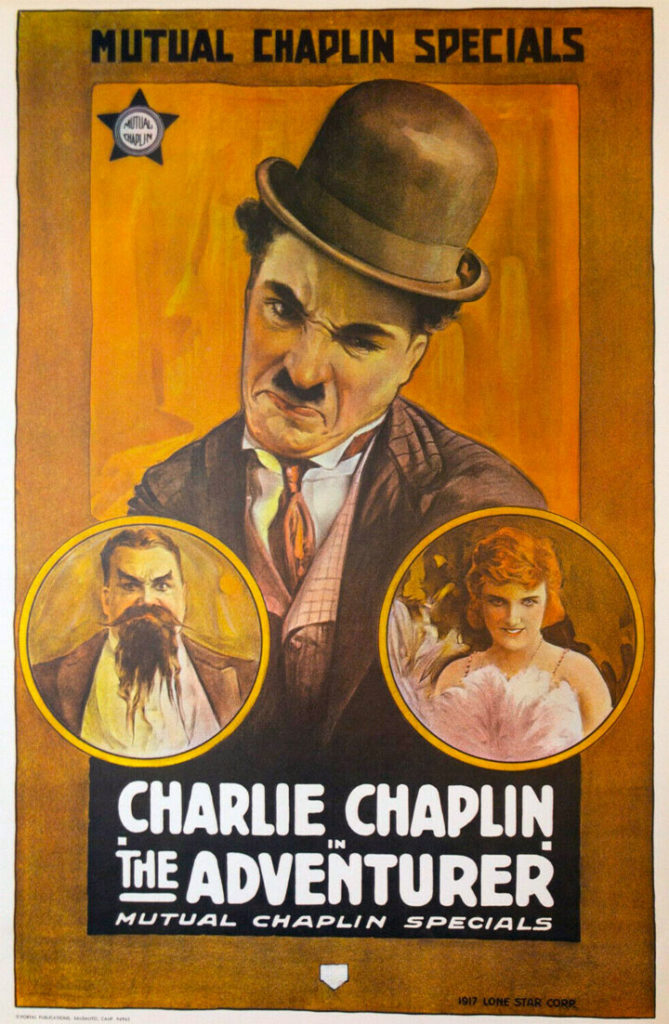In revisiting one of Chaplin’s best comedy shorts, one of my and many others’ favorites, I noticed something slightly unusual about its title. I wrote my first orchestral score for a silent film – this one – about twenty years ago, and it was time it got a gut-renovation. But, where to start?
I knew the score I’d written was ready for a redux. Well, according to me anyway. I’ve gotten positive feedback from the orchestras who’ve licensed it. I’ve heard my score performed by an orchestra at shows a few times, and the film’s gone over great with the audiences.
But the new digital restoration of The Adventurer is longer, because of the running speed, and my 1999 score – which synchs with the older p.d. version – won’t line up with the new edition. More importantly, I feel like I’ve grown as a silent film composer, and in particular as an orchestral one, since I wrote my score for this short.
On the most recent episode of my podcast, I talk about what happened when I played for Chaplin’s The Adventurer three days in a row with three different audiences, trying to make the score and themes I’d composed for the orchestral score work with the film…with results that confirmed my decision to reboot what I’d composed for the film.
What guided me in revisiting Chaplin’s final entry for Mutual was trying to grasp what the film’s journey actually was about. And what struck me as I went down this right brain rabbit hole was the film’s title — The Adventurer.
In The Floorwalker, Charlie gets a job as a department store floorwalker. He is a fireman in The Fireman, a homeless itinerant violinist in The Vagabond, masquerades as a count in The Count, immigrates to the United States in The Immigrant, goes skating in The Rink, and so on for eleven of the golden dozen two-reelers made 1916-17.
In The Adventurer (1917), Charlie is an escaped convict who hides out at a wealthy woman’s mansion after saving her and her mother from drowning (a gag sequence it looks like he lifted from a 1916 Marcel Perez comedy), until the police arrive and the chase resumes. This isn’t anything earth-shatteringly revelatory, but it did help reframe the Charlie-and-Edna trajectory for me. It’s usually one of flirtation-to-romance, but here convict Charlie a/k/a “the Eel” is on more of a forward trajectory, trying to stay ahead of The Law.
Sure, I may be overthinking this. But Chaplin could easily have followed his pattern and called the film Convict 13, which is the name of Buster Keaton’s 1921 prison-based comedy short. He could have been thinking of or inspired by the old Fred Karno sketch “Jail Birds”. But I needed more of a hook to re-score the film than creating music beds, like the old mood cues of the silent era, and aligning them with the different scenes.
The existing score I composed is fine and works great, and is still available. The new one will be way way better, IMHO – it will have its premiere in February 2020 in a performance by the Boise Philharmonic’s Chamber Ensemble.

After the Mutuals, the First National period was disappointing. Between 1918 and 1923, Charlie got a bit lazy.
I’ve always thought that losing Eric Campbell as an ideal adversary and villain in 1917 threw things off for a while, eventually being replaced by the notion of survival as a homeless person. “A Dog’s Life” is one of my favorites from this period, and is probably one of his best shorts.
And I’m partial to SUNNYSIDE. Go figure!
There’s no accounting for taste! I’m sure “Three’s a Crowd” has its fans, too. ;)
Well, now, that’s just insulting! :-P
I agree. Losing Eric must have been a major trauma. Did you ever see the documentary on him, Chaplin’s Goliath? There are included some screen tests of possible replacements – all pretty pathetic. Charlie was wise to recruit Mack Swain.
I’ve seen the Campbell doc, but it’s been a long time since I’ve looked at it.